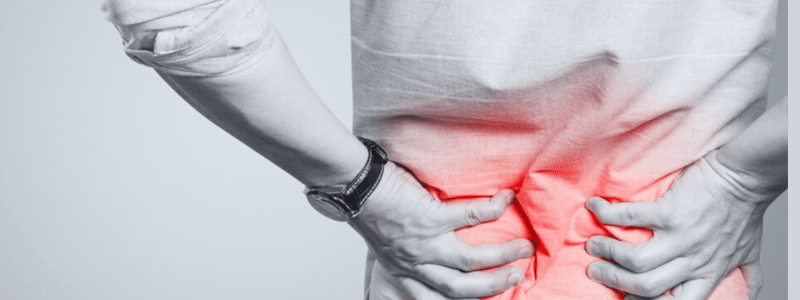Sciatica Lower Back and Leg Pain: Causes and Chiropractic Treatments

What is Sciatica
Sciatica is a circulating leg pain triggered by a problem with the sciatic nerve. The nerve is the thickest and longest in the body. It travels from the lower back, past the hips, and down to the back of each leg.
Sciatica pain occurs when something is pinching, irritating, or putting pressure on the sciatic nerve. This effect causes pain in the lower back, circling to the hips, legs, and buttocks. The pain can be felt anywhere within this path and is often prevalent throughout the whole nerve.
Sciatica pain can be mild or severe. It can come as a sharp, shooting back and leg pain. It causes the foot and leg to feel weak or numb. Other times, patients experience pain like an electric shock, stabbing, or an unpleasant tingling.
According to an NCBI study, sciatica is common, affecting about 40% of Americans. The pain often resolves on its own, without needing surgery. However, sometimes it can result in muscle weakness and chronic lower back and leg pain.
Chiropractic care is a popular treatment for Sciatica. It offers natural therapy without medication at the lowest cost and provides the highest patient satisfaction.
Causes of Sciatica:
Inflammation
The spinal nerves can experience inflammation from trauma such as a slip, fall, arthritis, or heavy lifting. These traumas can cause damage to the sciatic nerve. As a result, Inflammation occurs and puts pressure on the nerve, thereby causing pain.
Piriformis Syndrome
Piriformis syndrome is a common but underrated cause of Sciatica. It happens when the piriformis muscle, a small muscle found deep within the buttocks, becomes spasms or tight. The piriformis muscle runs over the sciatic nerve. So when it becomes tight or spasms, there’s pressure and irritation on the sciatic nerve.
Disk Herniation
The spinal column has a series of bones stacked onto each other. Disks act as a cushion between these bones. The disks protect them because it helps absorb the shocks from lifting, twisting, and walking.
Each disk comprises a soft inner portion and rigid outer ring. Disk herniation occurs when there’s weakness or injury on the inner part. This weakness makes it protrude through the outer ring, causing pain and discomfort. A quarter of people will experience symptoms for up to 6 weeks.
Spinal Stenosis
The spinal canal can begin to narrow when natural wear and tear or damage happen to the vertebrae. Spinal stenosis is a term used to describe this narrowing. It can put pressure on the sciatic nerve, thus affecting balance, sensation, or walking. The condition is prevalent among adults aged over 60.
Spinal Tumors
Tumors can grow inside, within, or along the lumbar spinal canal. When this happens, it puts pressure on the sciatic nerve and compresses it.
Sacroiliitis
Sacroiliitis is a condition that occurs when there’s inflammation on either or both of the sacroiliac joints. The joints serve as a connection between the lower spine and the pelvis. Sacroiliitis causes buttocks and lower back pain which can travel down both legs.
When patients stand or climb stairs frequently, the situation can worsen. Pregnancy, infection, injury, or carrying heavy loads are other causes of Sacroiliitis.
How Chiropractic Treatment May Help Treat Sciatica
Sciatica can result in more frustrating and complicated conditions if not handled properly. Medical treatment options include pain medications, lifestyle, and surgery in severe cases.
However, Chiropractic seems to offer natural treatment for Sciatica without using medications. Chiropractic care is considered a safe treatment. Furthermore, it provides long-term pain management compared to medication.
Chiropractic care uses spinal manipulation and other manual therapies to minimize pain. It focuses on the entire body and not just the area of pain. A chiropractor can ask for the patient’s medical history or X-rays to be taken to understand the causes of the pain.
A chiropractic adjustment will focus on realigning the patient’s spine. This adjustment relieves pressure off the sciatic nerve and brings relief. Treatment includes stretching and applying regulated pressure on the joints. Specific exercises and nutritional diets can also be recommended to help relieve leg pain.
When the pressure is relieved, the body can begin healing. Beyond chiropractic adjustments, other treatments might be administered, too, especially when adjustments are not approved. Such treatments include ultrasound usage, ice therapy, or a TENS device( Transcutaneous electrical nerve stimulation).
Ultrasound will help soothe the region and maximize circulation, thereby reducing swelling and muscle tension. The TENS device offers comfort by using an electric charge to calm muscle spasms and boost endorphins.
While Sciatica may go on its own, it could result in complications if not handled properly. Chiropractic care brings needed relief without surgery or medication.

